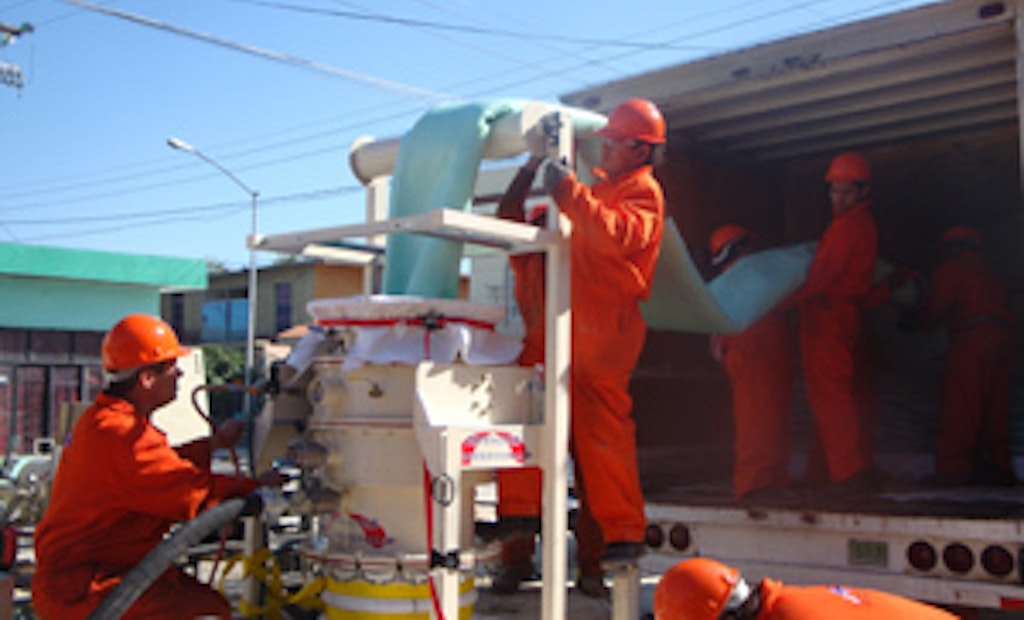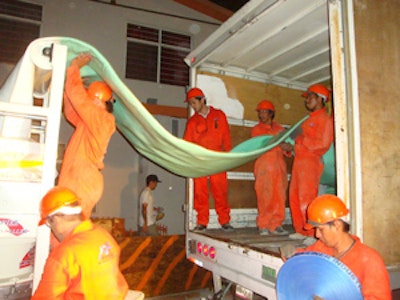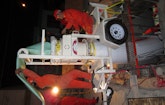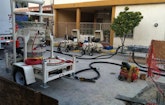
Ruptures in a 24-inch force main flooded homes in Guadalupe and jeopardized production at the 235,000 barrel-per-day PEMEX oil refinery in Cadereyta Jiménez, Nuevo León, Mexico. The facility, which owns the pipe, uses recycled effluent from the Monterrey Wastewater Treatment Plant for cooling and other processes.
The force main, one of four, is the most important feeder to the treatment plant. The City of Monterrey issued a state of emergency and requested bids to rehabilitate the sewer. ACE DuraFlo de Mexico (ADF) in Monterrey, received the contract.
“We use Perma-Liner cured-in-place products and have a refrigerated truck, but we had never shot 24-inch liners,” says co-owner and project manager Eduardo Ortegon. “PEMEX said that it would be a national catastrophe if the refinery ran out of water because the pipe wasn’t back in service on time.”
With so much at risk, Perma-Liner president Jerry D’Hulster arrived to assist the first shoot and colleague Jim Gould remained for the duration. ADF crews faced working in high-traffic areas, crossing the 400-foot-wide Santa Catarina River, and accessing the pipe on a cycle of five out of 14 days. The project was completed on schedule.
Hired gun
Laid in 1984, the 5,000 feet of pipe from the pump station to the treatment plant had no manholes and multiple 45- and 90-degree bends. Homes were built over the main as Guadalupe expanded.
“Since we had to excavate access pits, we bought the trailer-mounted Top Gun F-24 manhole-to-manhole continuous CIPP lining system, two Viper compact steam units with 1-inch hoses, and the manifold to control steam and air pressure,” says Ortegon.
The refinery needed nine days to fill water storage tanks totaling 103 million gallons. ADF used the time to excavate and shore a dozen 6- by 10-foot-wide pits 7 to 11 feet deep. Most excavations were in high-traffic streets. “Even though we closed the block, it still involved lots of traffic control,” says Ortegon.
The overflows had given residents a negative attitude toward PEMEX, making public relations important. “Our human resources manager talked to people almost daily,” says Ortegon. “He also handed out information on the project’s benefits or left door hangers.”
Monday through Friday
Access to the main began around 8 p.m. on a Monday when the lift station operator closed the valves. From a pit near the river, ADF dewatered the pipe by pumping sewage to the treatment plant. The process took eight to 12 hours.
After the main was dewatered, the crew removed a 6-foot section in three or more pits, welded flanges to the ends of the exposed pipe, and sealed the mouths of the unaffected pipe to ensure the work area was watertight. When a shutdown began, they worked almost around the clock until early Saturday morning when the sewer went live.
The main had minor tuberculation and joints attacked by hydrogen sulfide. Crews cleaned it with a truck-mount jetter from Aquatech (Hi-Vac Corp.). Then a worker downstream tied a rope to the jetter and the upstream person pulled it back to attach a Guzzler vacuum hose. “We pulled the hose through to suck up all the water and launched our CUES camera behind it,” says Ortegon.
ADF began by shooting liners in both directions from a central pit. Workers laid steel vehicle ramps lengthwise over the opening, then positioned the Top Gun trailer in line with them. A push of a button then activated the wheels to move the trailer forward.
“The inversion unit was on the far side of the host pipe, enabling us to put a 45- to 60-degree bend in the liner by using a strap or pushing it by hand,” says Ortegon. “This positioned the liner so it went straight into the pipe.”
Physical feat
The crated, impregnated custom liners arrived in a refrigerated truck and were transported to the job site as needed. Eight to 10 workers labored to uncrate the liner and hand-feed it onto the tower roller, then down into the gun’s diaphragm bladder.
Once they clamped the liner to the gun’s inversion head, a 1,000 cfm air compressor held pressure on the bladder at 15 and 20 psi, but it required less than 5 psi to send the liner rolling through the pipe. Curing took around 75 minutes with one worker controlling the steam and air pressure and another with a walkie-talkie at the exit pit to relay temperatures from a thermocoupler. “We located the wire about a foot inside the host pipe and on the bottom of the liner,” says Ortegon.
After both ends of the liner reached 200 degrees F, the manifold operator shut off the steam and applied air at 5 psi for about an hour to cool the liner. As the liner neared ambient temperature, workers cut away the protruding material at both ends.
ADF inspected the liner, then used a crane to replace the removed pipe sections with carbon steel pipe twice as thick as the original. In one instance, crews poured a reinforced concrete manhole.
Elevated heart rate
ADF shot 13 liners during four sewer shutdowns. The longest runs were 550 feet and the shortest was 155 feet. Ortegon saved the most difficult shot – a 410-foot run under the river – for last.
“That section had one 90-degree and two 45-degree bends,” says Ortegon. “The depth of the pipe went from 20 to 40 feet as it passed under the river, then rose again. It took 15 hours just to clean.”
Shooting the liner went smoothly until it hung up on the right-angle bend halfway under the river. Gould increased the air inversion pressure incrementally, hoping to nudge the liner around the corner.
“If the liner blew inside the bladder, I’d be living in Africa now,” says Ortegon. “We couldn’t excavate in the river and our failure would cause a national disaster.”
With the gauge reading 35 psi – seven times the normal pressure – the liner gave no signs of wanting to budge. “It was stressful,” says Ortegon. “I had to look away for a second, heard a boom, and the liner was out the other end just that fast.” The project restored the refinery’s major source of water and ended sewer overflows in Guadalupe.













